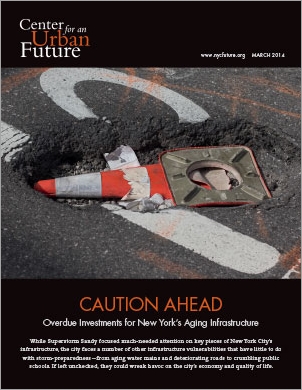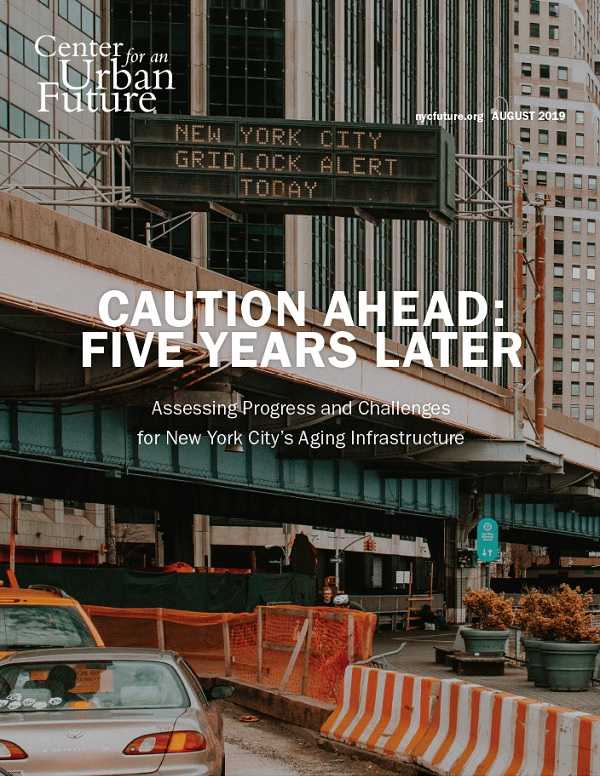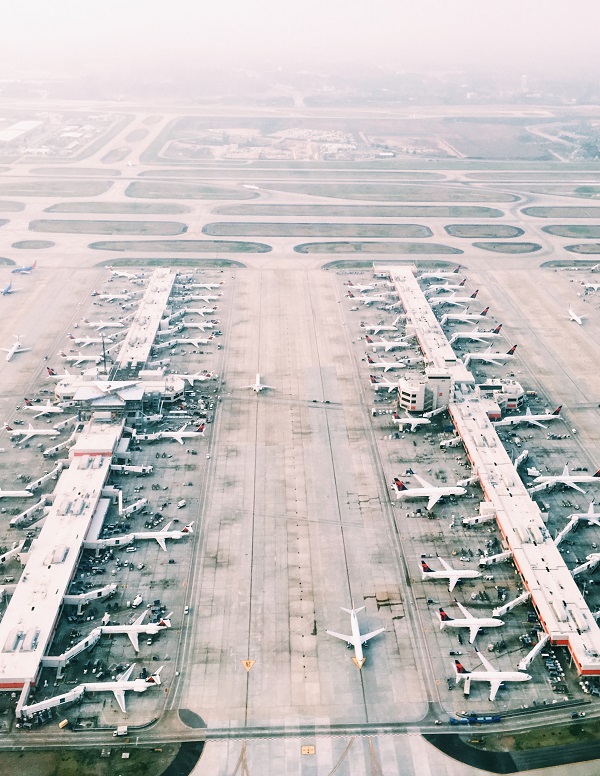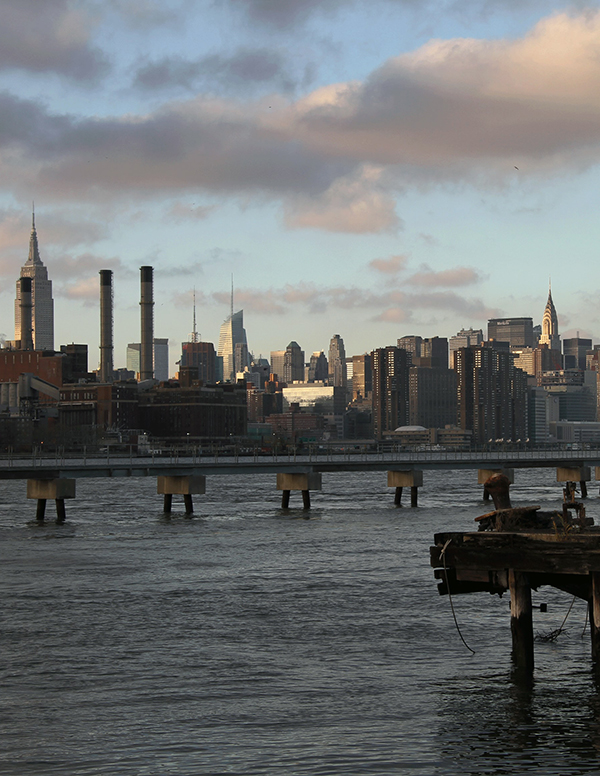Bringing all these physical assets into a state of good repair will require a nearly unprecedented investment by the city, state and federal governments. According to the city’s Asset Information Management System (AIMS) report, just 18 city agencies have $6.3 billion worth of so-called state of good repair needs over the next four years, including $3.2 billion at DOT, $1.3 billion at the Department of Education (DOE), $471 million at the Department of Parks, and $282 million at the Health and Hospitals Corporation (HHC). In a recent building condition assessment survey, CUNY itemized $2.5 billion in immediate capital needs, 11 times more than what is outlined in the city’s FY2014 AIMS report. And, in their five-year capital plans, NYCHA, New York City Transit and the Port Authority identified $15.5 billion, $16.3 billion and $6.8 billion in state of good repair needs, respectively.
That comes to a total cost of $47.3 billion over the next four to five years. And this only reflects repairing and maintaining current infrastructure—not needed service expansions such as building new sewers or bus rapid transit lines.
The enormous backlog of needs goes back decades and is partly attributable to the lack of adequate investment over many years. Between 2002 and 2013, Mayor Michael Bloomberg increased city capital spending significantly over what the three previous mayors spent during their tenures. At the DEP, the construction of Water Tunnel 3 was reinvigorated after years of neglect, and the School Construction Authority expanded public schools by 126,000 seats. Major new parks were built and the number 7 train will be extended to the far west side of Manhattan using city capital dollars.
Still, when it came to maintaining existing assets, a number of New York City agencies lost ground during the Bloomberg administration. According to AIMS, between Fiscal Year 2009 and Fiscal Year 2014, capital needs at the Department of Correction grew by 181 percent, at HHC by 72 percent, DOE by 71 percent and the Department of Homeless Services by 47 percent. According to its own assessment, CUNY’s backlog of needs went from $1.7 billion in 2007 to $2.5 billion in 2012, a 47 percent jump.
Though DOT capital needs increased by a more modest 8 percent over the last five years, the agency has resurfaced an average of only 852 lane miles of road a year since 2000, even though an estimated 1,000 lane miles fall out of good repair every year. Similarly, to stave off water main breaks, experts believe that the DEP should follow a 100-year replacement cycle, which would mean replacing the equivalent of 68 miles of water mains every year. But the agency has failed to reach this target a single time over the last decade.
There is a huge gap across the board between the backlog of the city’s capital needs and funding levels. Based on accumulated funding gaps and shortfalls in upcoming capital plans, unmet “state of good repair” needs will reach $34.2 billion over the next five years. This includes deferred capital maintenance at the New York City Transit Authority ($10.5 billion) and CUNY ($2.5 billion) and projected shortfalls at NYCHA ($14 billion), Port Authority ($3.9 billion) and 18 city agencies ($3.3 billion).
To overcome this enormous backlog, the report urges Mayor de Blasio to make a significant new infrastructure investment and refocus the city’s capital spending on state of good repair needs. Ramping up the city’s investment will not be easy without additional resources from Albany and Washington, something that seems unlikely at the moment given the paralysis in Congress. But the report suggests that a major public works program to tackle the city’s aging infrastructure could be one of the most effective ways to create middle-income jobs in the five boroughs, a clear policy goal of the de Blasio administration.
The report recommends several possibilities for new dedicated revenue sources to pay for infrastructure projects—including a Surface Water Management Fee, tolls on the East River bridges and a residential parking permit program—as well as new mechanisms to capture the value created by infrastructure projects. It calls on city and state officials to end the practice of diverting existing dedicated revenue streams from the transit system, airports and the water system.
To ensure that the city’s limited capital dollars go farther, state and city officials will also need to reduce the cost of construction on capital projects. Public sector construction projects in New York cost more and take longer than equivalent work in the private sector; they also tend to cost significantly more than equivalent work by public sector agencies in other cities. For instance, in 2012 replacing or repairing public school electrical and mechanical systems in New York City cost 67 percent more than in Denver, 46 percent more than in Seattle and 18 percent more than in Chicago. In Tokyo the cost of building a new subway line is approximately $448 million per mile; in Paris, it is roughly $368 million per mile. By comparison, New York’s Second Avenue subway and 7 train extension have each cost the MTA well over $2 billion per mile.
The report recommends a number of changes to state and city contracting laws and practices that could bring down construction costs.
The massive scale of infrastructure needs also requires a more comprehensive capital planning process. While the Office of Management and Budget (OMB) commissions the Asset Information Management System report, some experts say that its assessments are often cursory and it excludes huge portions of the city’s assets such as water mains, treatment plants and sewer pipes. Rather than basing capital allocations on the needs outlined in the report, OMB has tended to base funding levels on a mixture of precedent, persuasion and debt capacity.
“The city needs more sophisticated and practical long-term planning,” says Stephen Berger, former executive director of the Emergency Control Board and an expert on capital budgeting.
There also must be more coordination between capital and maintenance spending. When buildings are not maintained properly on a day-to-day basis—when the snow isn’t cleared off the roof and routine malfunctions are not taken care of in a timely fashion—properties become distressed and capital costs increase.
Coming to terms with New York’s huge state of good repair needs is an immense challenge, but the city’s health, quality of life and economic competitiveness depends on it. “If New York City wants to maintain its presence in the world, among other leading global cities, we have no choice but to maintain this infrastructure,” says Mary Ann Tighe, New York Tri-State Region CEO for real estate firm CBRE. “We’re selling talent above all in New York. But the talent won’t come here without a strong infrastructure and environment.”
“It’s an issue of competitiveness and livability,” adds Elliot Sander. “If our infrastructure is not advanced to an acceptable level and then maintained, these systems will degrade. We know from the 1980s that these systems will fall apart. It came very close to killing the city and region. You probably need to double the investment to both bring all the elements up to a state of good repair and to deal with the added demand from the growth we have had, and then put it on a regular replacement cycle. We also need to get more for our money. It will be difficult to do all of this financially and politically. But if we continue on the current course, it is likely New York will be substantially diminished as a global leader, with enormous environmental, social, political, and financial implications that far outweigh the cost.”
This report is intended to prompt a serious discussion among community leaders and the general public that the infrastructure vulnerabilities discussed here must be addressed if New York City is to remain a dominant global urban destination. While the report is a deep dive into the state of disrepair of the backbone infrastructure of what makes New York work, it is not a substitute for the study and documentation of the respective expertise of each of the discussed infrastructure systems. Our study is intended to shine a light on what their needs truly are.
This was the introduction to Caution Ahead. Click here to read the full report (PDF).
Recommendations
Though New York’s essential infrastructure has improved over the past 25 years, a look under the hood reveals a number of critical vulnerabilities. From structurally deficient bridges and deteriorating roads to leaking water pipes, antiquated airport terminals, decaying school buildings and fraying copper telecom wires, too much of New York’s infrastructure is unworthy of a growing and global city facing increased competition for talented workers and business investment.
To be sure, we do not expect New York policymakers to address every one of the city’s infrastructure vulnerabilities at this time. Policymakers will need to prioritize. But if a significant chunk of the city’s critical infrastructure is not brought to a state of good repair in the years ahead, it could seriously undermine the city’s economic competitiveness and quality of life—and lead to substantial long-term costs.
In Caution Ahead, we lay out more than a dozen recommendations for city and state policymakers to address these challenges. Our ideas fall into four key areas: 1) Increasing Infrastructure Investments; 2) Bringing Down Infrastructure Costs; 3) Improving Infrastructure Planning; and 4) Developing New Infrastructure Innovations.
Increasing Infrastructure Investments
Make investing in NYC’s aging infrastructure a key part of the de Blasio administration’s plans to create middle-income jobs
With 35 percent of working adults in New York City in “low-wage jobs” and nearly one in ten working New Yorkers earning too little to officially climb above the federal poverty line, it’s refreshing that Mayor Bill de Blasio is looking to develop new strategies for creating middle-income jobs. The de Blasio administration should consider a sizable public works program. It’s hard to think of any other city action that could generate more blue-collar jobs than an increased and sustained investment in repairing the city’s aging infrastructure. Such a program could include new apprenticeship programs and job training to ensure that a diverse mix of New Yorkers can access these jobs and build long-term skills in the construction trades.
Refocus capital spending on state of good repair needs
During the 12 years of the Bloomberg administration, city infrastructure investment reached new highs but the overwhelming focus was on expanding capacity—developing new parks, schools, water infrastructure, subway extensions, etc.—rather than on repairing aging assets. It’s now time to focus on preserving existing infrastructure. The de Blasio administration should devote a larger share of the capital budget to state of good repair work and favor new infrastructure projects that explicitly relieve overburdened assets, thus extending their useful life.
Identify new dedicated revenue sources to pay for infrastructure projects—and stop diverting money from existing “dedicated” funding streams
To finance the city’s growing state of good repair needs, the city must develop new dedicated revenue sources. For example, the New York Building Congress has suggested the city implement a residential parking permit program, with the revenues going to transportation infrastructure projects. Another possibility is environmentally sound Waste to Energy facilities which, according to the Building Congress and the Citizens Budget Commission, would reduce waste disposal costs and create a potential revenue stream to support the city’s sanitation operations. But policymakers should look to identify other opportunities. In the years ahead, if the state ultimately decides to legalize fracking, it should consider dedicating a share of the potentially lucrative new tax revenues for infrastructure projects.
In addition, city and state officials should refrain from diverting or dipping into the already-insufficient dedicated revenue streams, a practice that has been all-too-common in recent years.
Implement East River tolls or congestion fees
City and state policymakers should get behind plans to establish a fairer bridge toll system to reduce vehicle congestion in the city’s central business districts and create a needed mechanism for funding transit infrastructure projects. Though prior efforts to impose tolls on the East River bridges—including Bloomberg’s congestion pricing initiative—were dead on arrival in the state legislature, there are indications that newly designed bridge tolling proposals could gain broader support. For instance, while Sam Schwartz’s “Fair Plan” would add new tolls on the East River bridges that bring vehicles into the central business district, it would sharply reduce tolls on bridges that don’t enter the Manhattan’s business district. Most importantly, Schwartz’s plan would result in $1.2 billion annually for transit projects and regional highway improvements. At a time when transit ridership is at record levels but the MTA’s precarious finances have left the authority without funds to maintain and improve the system, Mayor de Blasio, Governor Cuomo and other city and state policymakers must throw their full support behind this—or some alternative—bridge tolling plan.
Introduce a Surface Water Management Fee to incentivize capture of rainwater before it enters sewers
To address the roughly 27 billion gallons of raw sewage and polluted stormwater that enter local waterways each year, the city has increased the number of green elements in New York City streets and parks, absorbing rainwater before it enters the sewer system. To incentivize similar rainwater capture on private property, the DEP should consider introducing a Surface Water Management Fee. Customers would be billed based on the percentage of their lot featuring impervious surfaces. The more green elements added—such as grass, gardens, green roofs and permeable concrete—the lower the fee.
Over 500 utilities currently apply stormwater charges, including Philadelphia, Washington DC, and Seattle. Sophisticated Geographical Information Systems (GIS) programs enable these utilities to track impervious surface area in order to maintain accurate assessments. This new revenue source could be coupled with a credit program to help customers finance the installation of green elements on their property; repaid each month via the utility bill.
Create new mechanisms to capture value from infrastructure projects
Over the past 15 years, much of the public investment in new parks, transit, schools and other infrastructure across the five boroughs has led to significant increases in nearby property values. But as Chris Ward, former executive director of the Port Authority, laments, “We’ve lacked the capacity to capture that wealth” to help underwrite the cost of those public investments. One example is the development of the Hudson River Park, where hundreds of millions of dollars of investment by city and state agencies has sparked a wave of new housing and commercial development in the surrounding blocks, creating financial windfalls for the property owners. City officials should consider ways that those benefitting most from the improvements could contribute to their financing.
In London, for instance, the Community Infrastructure Levy helped finance major infrastructure improvements, including the city’s ambitious Crossrail, a new commuter rail line connecting the suburbs to central London. Surrounding neighborhoods were assigned to one of three zones, depending on their proximity to the new line. In areas that are closest to the new rail line, new development is taxed at £50 per square meter. In the next two zones, the levy falls to £35 per square meter and £20 per square meter.
New York City could introduce a similar mechanism for residential construction around new parks, bus rapid transit, subway lines and any other infrastructure that bolsters real estate values. The city has experimented with forms of value capture at Hudson Yards and Brooklyn Bridge Park. London’s Community Infrastructure Levy offers a more systematic and ambitious model.
More federal support
While America’s global competitors invest in new airports, transit systems, schools, telecommunications networks, smart energy grids and highways, the United States government is providing less and less infrastructure funding to America’s most important global city. This needs to change. New York and other cities simply do not have the resources to tackle their aging infrastructure alone. In his 2014 State of the Union address, President Barack Obama urged Congress to provide ample revenues for “rebuilding our roads, upgrading our ports, unclogging our commutes.” Then, in February 2014, President Obama proposed a $302 billion dollar transportation spending package to address the nation’s deteriorating infrastructure. Congress should embrace the challenge and develop a bipartisan framework to significantly increase resources for fixing and modernizing the nation’s infrastructure. Such a plan should help cities and states repair the oldest bridges, highways, airports and schools; upgrade public housing that was built by the federal government but is now rapidly deteriorating; and modernize transit infrastructure in cities where ridership levels are growing rapidly. It should consider competitive grants that empower cities to come up with innovative infrastructure solutions. Mayor de Blasio should team up with other mayors, business leaders and labor officials to put urban infrastructure needs on the national agenda and lobby Congress to fund a meaningful investment.
A lift from Albany
Governor Cuomo made infrastructure investment a key part of his 2014 State of the State speech, noting, “We have to rebuild our infrastructure because we need a 21st century infrastructure to build on.” The governor proposed major state investment to modernize JFK and LaGuardia airports and build new Metro North stations in parts of the Bronx that are underserved by the subway system. He called for a referendum that, if passed by voters, would provide $2 billion to upgrade the technology infrastructure in schools across the state. This is a very important start, but the state must do far more to support New York City’s infrastructure needs.
Given that New York City is the state’s economic engine, the governor and legislature have a responsibility to help modernize its aging infrastructure. Albany leaders can start by upping its investments in New York City highways that are managed by the state Department of Transportation and which have seen declining levels of maintenance in recent years. It should also provide more stable support for the Metropolitan Transportation Authority’s (MTA’s) capital plan and honor its capital commitments to City schools mandated in the Campaign for Fiscal Equity litigation. Beyond this, Governor Cuomo and the legislature should introduce a much larger package to modernize bridges, roads, transit systems, schools and energy infrastructure from Brooklyn to Buffalo.
Officials in Albany could follow the lead of several other states that recently developed innovative approaches to funding infrastructure. For instance, Pennsylvania legislators recently approved a package of tax and fee changes that will raise $2.3 billion a year for transportation infrastructure. Maryland raised the gas tax for the first time in 20 years, passed a measure to index the tax to keep pace with inflation and levied a new sales tax on gasoline—all of which will enable the state to pump $4.4 billion into transportation infrastructure projects over the next six years. In Massachusetts, the legislature approved a transportation infrastructure financing bill that includes a three-cent per gallon hike in the gasoline tax and a $1 per pack cigarette tax increase. All together it will provide up to $800 million in new annual revenue for transportation by 2018. And in January 2014, the state’s governor proposed an additional $12.4 billion package to modernize the state’s infrastructure by pumping billions of dollars into transportation.
Stop diverting airport revenue
JFK and LaGuardia airports both require significant infrastructure investments, yet hundreds of millions of dollars in revenues generated by these airports have been diverted to other Port Authority assets, such as the PATH train system. Federal regulations require airport operators to reinvest all revenue into their facilities to prevent cities from irresponsibly using their airports as a “cash cow.” The Port Authority is the only major airport operator in the nation that has been granted an exception to this mandate. With the city’s airports in need of significant new investment, de Blasio and other city and state policymakers should push the Port Authority to end this practice—or commit to a ceiling on how much can be diverted from each airport—and reinvest funds into the modernization of JFK and LaGuardia.
Create an infrastructure bank to help select and finance projects with high strategic and economic potential
When structured appropriately, and provided sufficient resources, government infrastructure banks can be an effective way to stretch funding while continually targeting new needs. Effective banks like California’s Infrastructure and Economic Development Bank (I-Bank) are able to make their initial capitalizations go much further in terms of loans by securitizing bonds with loan repayments; the I-Bank, for instance, started out with approximately $180 million in 1999 and has since made over $400 million in loans to a wide variety of agencies, authorities and nonprofits. But rather than using the bank to finance projects chosen by other entities—whether an agency or elected official—California’s I-Bank uses a competitive application process to select only those projects with an economic return. As Chicago’s relatively new Infrastructure Trust demonstrates, this model could also help the city or state tap into private funding sources. Chicago’s Infrastructure Trust has so far raised $1.7 billion in funding from Citibank, JP Morgan and other banks, and as with the I-Bank, loans are to be repaid through revenue generating and cost savings opportunities. As we demonstrate in this report, New York has no shortage of such projects: Building retrofits at NYCHA and the city’s libraries could generate significant energy savings, for example, while an expansion of fiber in the city’s former manufacturing areas, where tech start-ups are often stymied by poor broadband service, would create a clear source of new revenue.







